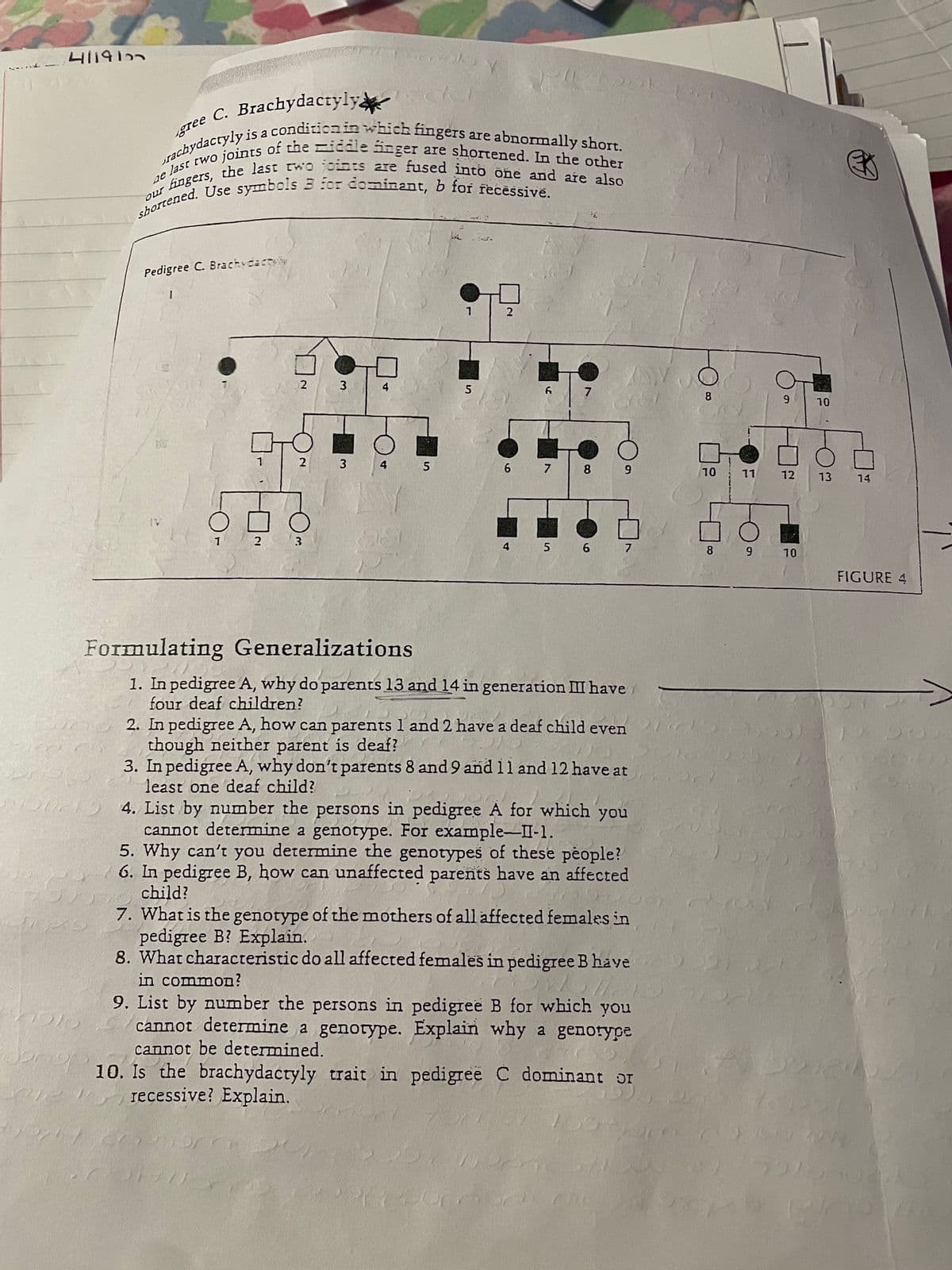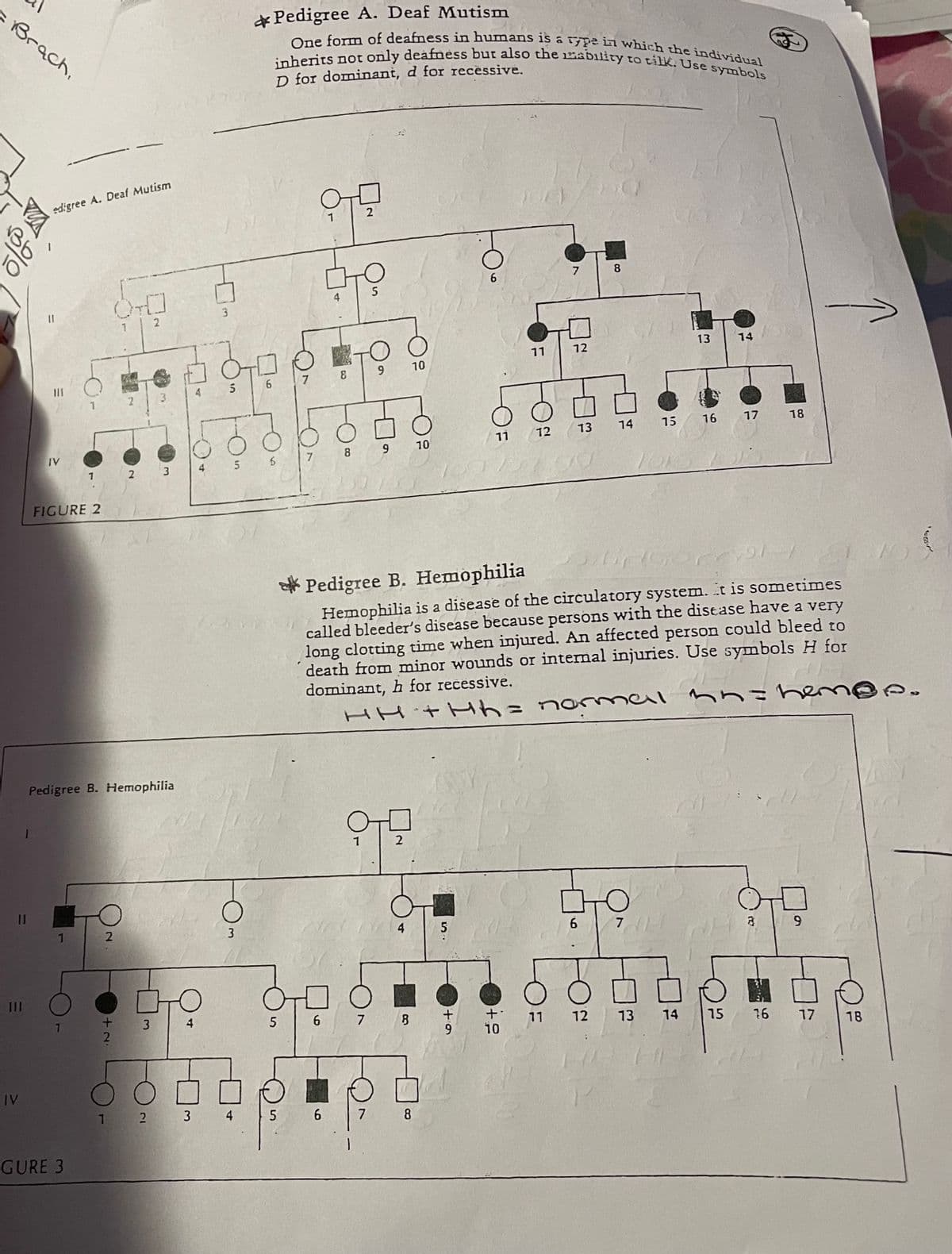Use symbols 3 for dominant, b for recēssivé. dactyly is a condizicain which fingers are abnomally short. ers, the last Ewo joints are fused into one and are also Ewo joints of the iddle änger are shortened. In the other e C. Brachydactyly E Brachvca 4 9 10 5 6 7 8 9 10 11 12 13 14 2 3 4 8 9 10 FIGURE 4 ng Generalizations igree A, why do parents 13 and 14 in generation II have eaf children? igree A, how can parents 1 and 2 have a deaf child even a neither parent is deaf? gree A, why don't parents 8 and9 and 11 and 12 have at one deaf child? - number the persons in pedigree A for which you determine a genotype. For example-II-1. an't you determine the genotypes of these pèople? gree B, how can unaffected parents have an affected s the genotype of the mothers of all affected females in e B? Explain. haracteristic do all affected females in pedigree B have mon? number the persons in pedigree B for which you determine a genotype. Explain why a genorype be determined. brachydactyly trait in pedigree C dominant or
Use symbols 3 for dominant, b for recēssivé. dactyly is a condizicain which fingers are abnomally short. ers, the last Ewo joints are fused into one and are also Ewo joints of the iddle änger are shortened. In the other e C. Brachydactyly E Brachvca 4 9 10 5 6 7 8 9 10 11 12 13 14 2 3 4 8 9 10 FIGURE 4 ng Generalizations igree A, why do parents 13 and 14 in generation II have eaf children? igree A, how can parents 1 and 2 have a deaf child even a neither parent is deaf? gree A, why don't parents 8 and9 and 11 and 12 have at one deaf child? - number the persons in pedigree A for which you determine a genotype. For example-II-1. an't you determine the genotypes of these pèople? gree B, how can unaffected parents have an affected s the genotype of the mothers of all affected females in e B? Explain. haracteristic do all affected females in pedigree B have mon? number the persons in pedigree B for which you determine a genotype. Explain why a genorype be determined. brachydactyly trait in pedigree C dominant or
Human Heredity: Principles and Issues (MindTap Course List)
11th Edition
ISBN:9781305251052
Author:Michael Cummings
Publisher:Michael Cummings
Chapter5: The Inheritance Of Complex Traits
Section: Chapter Questions
Problem 8QP: Clubfoot is a common congenital birth defect. This defect is caused by a number of genes but appears...
Related questions
Topic Video
Question

Transcribed Image Text:e last two joints of the idde inger are shortened. In the other
ingers, the last two joints are fused into one and are also
4119122
---
ETee C. Brachydactyly
Our
Pedigree C. Brachvcactyy
2 3
4
5
8.
10
3
5
8
OL
11 12
13
14
TV
2
4
5
7
8 9
10
FIGURE 4
Formulating Generalizations
1. In pedigree A, why do parents 13 and 14 in generation III have
four deaf children?
2. In pedigree A, how can parents 1 and 2 have a deaf child even
though neither parent is deaf?
3. In pedigree A, why don't parents 8 and 9 and 1l and 12 have at
least one deaf child?
4. List by number the persons in pedigree A for which you
cannot determine a genotype. For example-II-1.
5. Why can't you determine the genotypes of these pèople?
6. In pedigree B, how can unaffected parents have an affected
child?
7. What is the genotype of the mothers of all affected females in
pedigree B? Explain.
8. What characteristic do all affected females in pedigree B have
in common?
9. List by number the persons in pedigree B for which you
cannot determine a genotype. Explain why a genorype
cannot be determined.
10. Is the brachydactyly trait in pedigree C dominant or
recessive? Explain,
6.

Transcribed Image Text:One form of deafness in humans is a 17pe in which the individual
inherits not only deafness but also the ability to tilk. Use symbols
Brach.
*Pedigree A. Deaf Mutism
D for dominant, d for recessive.
edigree A. Deaf Mutism
7
8
5
4
3.
13
14
11
12
9
10
7
4.
14
15
16
17
18
12
13
11
9.
10
IV
2
3
4
FIGURE 2
o* Pedigree B. Hemophilia
Hemophilia is a disease of the circulatory system. t is sometimes
called bleeder's disease because persons with the distase have a very
long clotting time when injured. An affected person could bleed to
death from minor wounds or intemal injuries. Use symbols H for
dominant, h for recessive.
HHitHh= nomel nn= hem@e.
HH tHh=
ノJu
%3D
Pedigree B. Hemophilia
1
2
11
1.
3
4
III
7.
3
6.
7
11
12
13 14
15
16 17
9.
10
18
IV
1 2 3 4
5 6
7 8
GURE 3
2.
Expert Solution
This question has been solved!
Explore an expertly crafted, step-by-step solution for a thorough understanding of key concepts.
This is a popular solution!
Trending now
This is a popular solution!
Step by step
Solved in 2 steps

Knowledge Booster
Learn more about
Need a deep-dive on the concept behind this application? Look no further. Learn more about this topic, biology and related others by exploring similar questions and additional content below.Recommended textbooks for you

Human Heredity: Principles and Issues (MindTap Co…
Biology
ISBN:
9781305251052
Author:
Michael Cummings
Publisher:
Cengage Learning

Biology: The Unity and Diversity of Life (MindTap…
Biology
ISBN:
9781337408332
Author:
Cecie Starr, Ralph Taggart, Christine Evers, Lisa Starr
Publisher:
Cengage Learning

Biology: The Unity and Diversity of Life (MindTap…
Biology
ISBN:
9781305073951
Author:
Cecie Starr, Ralph Taggart, Christine Evers, Lisa Starr
Publisher:
Cengage Learning

Human Heredity: Principles and Issues (MindTap Co…
Biology
ISBN:
9781305251052
Author:
Michael Cummings
Publisher:
Cengage Learning

Biology: The Unity and Diversity of Life (MindTap…
Biology
ISBN:
9781337408332
Author:
Cecie Starr, Ralph Taggart, Christine Evers, Lisa Starr
Publisher:
Cengage Learning

Biology: The Unity and Diversity of Life (MindTap…
Biology
ISBN:
9781305073951
Author:
Cecie Starr, Ralph Taggart, Christine Evers, Lisa Starr
Publisher:
Cengage Learning